A Cerium Organic Framework with {Cu2I2} Cluster and {Cu2I2}n Chain Modules: Structure and Fluorescence Sensing Properties
Abstract
1. Introduction
2. Materials and Methods
3. Results and Discussion
3.1. Crystal Structure Analysis
3.2. Basic Measurements
3.3. Photoluminescence Studies
4. Conclusions
Supplementary Materials
Author Contributions
Funding
Institutional Review Board Statement
Informed Consent Statement
Data Availability Statement
Conflicts of Interest
References
- Cui, Y.J.; Yue, Y.F.; Qian, G.D.; Chen, B.L. Luminescent Functional Metal-Organic Frameworks. Chem. Rev. 2012, 112, 1126–1162. [Google Scholar] [CrossRef]
- Lustig, W.P.; Li, J. Luminescent metal–organic frameworks and coordination polymers as alternative phosphors for energy efficient lighting devices. Coord. Chem. Rev. 2018, 373, 116–147. [Google Scholar] [CrossRef]
- Cui, Y.; Chen, B.; Qian, G. Lanthanide metal-organic frameworks for luminescent sensing and light-emitting applications. Coord. Chem. Rev. 2014, 273–274, 76–86. [Google Scholar] [CrossRef]
- Kaur, H.; Sundriyal, S.; Pachauri, V.; Ingebrandt, S.; Kim, K.-H.; Sharma, A.L.; Deep, A. Luminescent metal-organic frameworks and their composites: Potential future materials for organic light emitting displays. Coord. Chem. Rev. 2019, 401, 213077. [Google Scholar] [CrossRef]
- Chen, W.; Zhuang, Y.; Wang, L.; Lv, Y.; Liu, J.; Zhou, T.-L.; Xie, R.-J. Color-Tunable and High-Efficiency Dye-Encapsulated Metal–Organic Framework Composites Used for Smart White-Light-Emitting Diodes. ACS Appl. Mater. Inter. 2018, 10, 18910–18917. [Google Scholar] [CrossRef]
- Cui, Y.; Zhang, J.; He, H.; Qian, G. Photonic functional metal–organic frameworks. Chem. Soc. Rev. 2018, 47, 5740–5785. [Google Scholar] [CrossRef]
- Hu, Z.C.; Deibert, B.J.; Li, J. Luminescent metal-organic frameworks for chemical sensing and explosive detection. Chem. Soc. Rev. 2014, 43, 5815–5840. [Google Scholar] [CrossRef]
- Liu, Y.; Xie, X.-Y.; Cheng, C.; Shao, Z.-S.; Wang, H.-S. Strategies to fabricate metal–organic framework (MOF)-based luminescent sensing platforms. J. Mater. Chem. C 2019, 7, 10743–10763. [Google Scholar] [CrossRef]
- Fang, X.; Zong, B.; Mao, S. Metal–Organic Framework-Based Sensors for Environmental Contaminant Sensing. Nano-Micro Lett. 2018, 10, 64. [Google Scholar] [CrossRef]
- Zhang, Y.; Yuan, S.; Day, G.; Wang, X.; Yang, X.; Zhou, H.-C. Luminescent sensors based on metal-organic frameworks. Coord. Chem. Rev. 2018, 354, 28–45. [Google Scholar] [CrossRef]
- Gawrońska, M.; Kowalik, M.; Makowski, M. Recent advances in medicinal chemistry of ampicillin: Derivatives, metal complexes, and sensing approaches. Trends Anal. Chem. 2022, 155, 116691. [Google Scholar] [CrossRef]
- Mendes, R.F.; Figueira, F.; Leite, J.P.; Gales, L.; Almeida Paz, F.A. Metal–organic frameworks: A future toolbox for biomedicine? Chem. Soc. Rev. 2020, 49, 9121–9153. [Google Scholar] [CrossRef] [PubMed]
- Yuan, R.; Li, H.-K.; He, H. Recent advances in metal/covalent organic framework-based electrochemical aptasensors for biosensing applications. Dalton Trans. 2021, 50, 14091–14104. [Google Scholar] [CrossRef]
- Gorle, D.B.; Ponnada, S.; Kiai, M.S.; Nair, K.K.; Nowduri, A.; Swart, H.C.; Ang, E.H.; Nanda, K.K. Review on recent progress in metal–organic framework-based materials for fabricating electrochemical glucose sensors. J. Mater. Chem. B 2021, 9, 7927–7954. [Google Scholar] [CrossRef]
- Dong, J.; Zhao, D.; Lu, Y.; Sun, W.-Y. Photoluminescent metal–organic frameworks and their application for sensing biomolecules. J. Mater. Chem. A 2019, 7, 22744–22767. [Google Scholar] [CrossRef]
- Liu, J.; Huang, J.; Zhang, L.; Lei, J. Multifunctional metal–organic framework heterostructures for enhanced cancer therapy. Chem. Soc. Rev. 2021, 50, 1188–1218. [Google Scholar] [CrossRef]
- Zheng, Q.; Liu, X.; Zheng, Y.; Yeung, K.W.K.; Cui, Z.; Liang, Y.; Li, Z.; Zhu, S.; Wang, X.; Wu, S. The recent progress on metal–organic frameworks for phototherapy. Chem. Soc. Rev. 2021, 50, 5086–5125. [Google Scholar] [CrossRef]
- Xu, C.; Pu, K. Second near-infrared photothermal materials for combinational nanotheranostics. Chem. Soc. Rev. 2021, 50, 1111–1137. [Google Scholar] [CrossRef]
- Bharmoria, P.; Bildirir, H.; Moth-Poulsen, K. Triplet–triplet annihilation based near infrared to visible molecular photon upconversion. Chem. Soc. Rev. 2020, 49, 6529–6554. [Google Scholar] [CrossRef]
- Saraci, F.; Quezada-Novoa, V.; Donnarumma, P.R.; Howarth, A.J. Rare-earth metal–organic frameworks: From structure to applications. Chem. Soc. Rev. 2020, 49, 7949–7977. [Google Scholar] [CrossRef]
- Xia, H.-L.; Zhou, K.; Guo, J.; Zhang, J.; Huang, X.; Luo, D.; Liu, X.-Y.; Li, J. Amino group induced structural diversity and near-infrared emission of yttrium-tetracarboxylate frameworks. Chem. Sci. 2022, 13, 9321–9328. [Google Scholar] [CrossRef]
- Xia, H.-L.; Zhou, K.; Wu, S.; Ren, D.; Xing, K.; Guo, J.; Wang, X.; Liu, X.-Y.; Li, J. Building an emission library of donor–acceptor–donor type linker-based luminescent metal–organic frameworks. Chem. Sci. 2022, 13, 8036–8044. [Google Scholar] [CrossRef]
- Liu, W.; Fang, Y.; Wei, G.Z.; Teat, S.J.; Xiong, K.; Hu, Z.; Lustig, W.P.; Li, J. A Family of Highly Efficient CuI-Based Lighting Phosphors Prepared by a Systematic, Bottom-up Synthetic Approach. J. Am. Chem. Soc. 2015, 137, 9400–9408. [Google Scholar] [CrossRef] [PubMed]
- Lucenti, E.; Cariati, E.; Previtali, A.; Marinotto, D.; Forni, A.; Bold, V.; Kravtsov, V.C.; Fonari, M.S.; Galli, S.; Carlucci, L. Versatility of Cyclic Triimidazole to Assemble 1D, 2D, and 3D Cu(I) Halide Coordination Networks. Cryst. Grow. Design 2019, 19, 1567–1575. [Google Scholar] [CrossRef]
- Artem’ev, A.V.; Davydova, M.P.; Hei, X.; Rakhmanova, M.I.; Samsonenko, D.G.; Bagryanskaya, I.Y.; Brylev, K.A.; Fedin, V.P.; Chen, J.-S.; Cotlet, M.; et al. Family of Robust and Strongly Luminescent CuI-Based Hybrid Networks Made of Ionic and Dative Bonds. Chem. Mater. 2020, 32, 10708–10718. [Google Scholar] [CrossRef]
- Wu, T.; Jiang, S.; Samanta, P.N.; Xie, Y.; Li, J.; Wang, X.; Devashis, M.; Gu, X.; Wang, Y.; Huang, W.; et al. Negative thermal quenching of photoluminescence in a copper–organic framework emitter. Chem. Commun. 2020, 56, 12057–12060. [Google Scholar] [CrossRef]
- Xu, C.; Lv, L.; Luo, D.; Liu, W. Synthesis, structure and photoluminescence properties of three copper(i) iodide based inorganic–organic hybrid structures with pyrazine derivatives. New J. Chem. 2020, 44, 14103–14107. [Google Scholar] [CrossRef]
- Vinogradova, K.A.; Shekhovtsov, N.A.; Berezin, A.S.; Sukhikh, T.S.; Rogovoy, M.I.; Artem’ev, A.V.; Bushuev, M.B. Coordination-induced emission enhancement in copper(i) iodide coordination polymers supported by 2-(alkylsulfanyl)pyrimidines. Dalton Trans. 2021, 50, 9317–9330. [Google Scholar] [CrossRef]
- Baranov, A.Y.; Ryadun, A.A.; Sukhikh, T.S.; Artem’ev, A.V. Luminescent Cu(I) and Au(I) complexes based on diphenyl(5-pyrimidyl)phosphine. Polyhedron 2022, 211, 115549. [Google Scholar] [CrossRef]
- Zhang, S.; Ong, C.-N.; Shen, H.-M. Critical roles of intracellular thiols and calcium in parthenolide-induced apoptosis in human colorectal cancer cells. Cancer Lett. 2004, 208, 143–153. [Google Scholar] [CrossRef]
- Resetco, C.; Hendriks, B.; Badi, N.; Du Prez, F. Thiol–ene chemistry for polymer coatings and surface modification–building in sustainability and performance. Mater. Horiz. 2017, 4, 1041–1053. [Google Scholar] [CrossRef]
- Prakash, M.; Shetty, M.S.; Tilak, P.; Anwar, N. Total Thiols: Biomedical Importance and Their Alteration In Various Disorders. Online J. Health Allied Scs. 2009, 8, 2. [Google Scholar]
- Wadhwa, S.; Mumper, R.J. D-penicillamine and other low molecular weight thiols: Review of anticancer effects and related mechanisms. Cancer Lett. 2013, 337, 8–21. [Google Scholar] [CrossRef]
- Qiao, Z.; Xu, Q.; Cheetham, A.K.; Jiang, J. High-Throughput Computational Screening of Metal–Organic Frameworks for Thiol Capture. J. Phys. Chem. C 2017, 121, 22208–22215. [Google Scholar] [CrossRef]
- Rao, Y.; Xiang, B.; Bramanti, E.; D’Ulivo, A.; Mester, Z. Determination of thiols in yeast by HPLC coupled with LTQ-orbitrap mass spectrometry after derivatization with p-(Hydroxymercuri)benzoate. J. Agric. Food Chem. 2010, 58, 1462–1468. [Google Scholar] [CrossRef]
- Jung, H.S.; Chen, X.; Kim, J.S.; Yoon, J. Recent progress in luminescent and colorimetric chemosensors for detection of thiols. Chem. Soc. Rev. 2013, 42, 6019–6031. [Google Scholar] [CrossRef]
- Yue, Y.; Huo, F.; Yin, C. The chronological evolution of small organic molecular fluorescent probes for thiols. Chem. Sci. 2021, 12, 1220–1226. [Google Scholar] [CrossRef]
- Chen, L.; Sun, L.; Ye, L.; Wang, Y. Fluorescent sensor array for selective recognition of biothiols. Opt. Mater. 2020, 106, 109961. [Google Scholar] [CrossRef]
- Chen, X.; Zhou, Y.; Peng, X.; Yoon, J. Fluorescent and colorimetric probes for detection of thiols. Chem. Soc. Rev. 2010, 39, 2120–2135. [Google Scholar] [CrossRef]
- Li, Y.-A.; Zhao, C.-W.; Zhu, N.-X.; Liu, Q.-K.; Chen, G.-J.; Liu, J.-B.; Zhao, X.-D.; Ma, J.-P.; Zhang, S.; Dong, Y.-B. Nanoscale UiO-MOF-based luminescent sensors for highly selective detection of cysteine and glutathione and their application in bioimaging. Chem. Commun. 2015, 51, 17672–17675. [Google Scholar] [CrossRef]
- Wang, J.; Liu, Y.; Jiang, M.; Li, Y.; Xia, L.; Wu, P. Aldehyde-functionalized metal–organic frameworks for selective sensing of homocysteine over Cys, GSH and other natural amino acids. Chem. Commun. 2018, 54, 1004–1007. [Google Scholar] [CrossRef]
- Wu, Z.-F.; Tan, B.; Gong, L.-K.; Zhang, X.; Wang, H.; Fang, Y.; Hei, X.-Z.; Zhang, Z.-Z.; Zhang, G.-Y.; Huang, X.-Y.; et al. A CuI modified Mg-coordination polymer as a ratiometric fluorescent probe for toxic thiol molecules. J. Mater. Chem. C 2018, 6, 13367–13374. [Google Scholar] [CrossRef]
- Wu, Z.-F.; Tan, B.; Velasco, E.; Wang, H.; Shen, N.-N.; Gao, Y.-J.; Zhang, X.; Zhu, K.; Zhang, G.-Y.; Liu, Y.-Y.; et al. Fluorescent In based MOFs showing “turn on” luminescence towards thiols and acting as a ratiometric fluorescence thermometer. J. Mater. Chem. C 2019, 7, 3049–3055. [Google Scholar] [CrossRef]
- Sheldrick, G.M. Crystal Structure Refinement with SHELXL. Acta Crystallogr. Sect. C Struct. Chem. 2015, 71, 3–8. [Google Scholar] [CrossRef]
- Spek, A.L. PLATON SQUEEZE: A tool for the calculation of the disordered solvent contribution to the calculated structure factors. Acta Cryst. C 2015, 71, 9–18. [Google Scholar] [CrossRef]
- Bhattacharjee, S.; Chakraborty, T.; Bhaumik, A. A Ce-MOF as an alkaline phosphatase mimic: Ce-OH2 sites in catalytic dephosphorylation. Inorg. Chem. Front. 2022, 9, 5735–5744. [Google Scholar] [CrossRef]
- Meng, B.-f.; You, W.-s.; Sun, X.-f.; Zhang, F.; Liu, M.-y. A hydrotalcitelike Ce(III) coordination polymer pillared by Keggin anions: Synthesis, single crystal structure and photocatalysis. Inorg. Chem. Commun. 2011, 14, 35–37. [Google Scholar] [CrossRef]
- Gao, S.; Bai, O.; Ma, B.-Q.; Yi, T.; Yan, C.-H.; Xu, G.-X. A novel two-dimensional 4f-3d coordination polymer Ce2Co3(EDTA)3(H2O)11·12H2O. J. Chem. Crystallogr. 2000, 30, 163–166. [Google Scholar] [CrossRef]
- Fan, Y.-H.; Wang, A.-D.; Bi, C.-F.; Xiao, Y.; Bi, S.-Y.; Zhang, X.; Wang, Q. Synthesis, crystal structure and anticancer activity of 2D-coordination polymer of cerium(III) with chiral Schiff base trans-N,N′-bis-(2-hydroxy-1-naphthalidehydene)-(1R,2R)-cyclohexanediamine. Synth. Met. 2011, 161, 1552–1556. [Google Scholar] [CrossRef]
- Cariati, E.; Bu, X.; Ford, P.C. Solvent- and Vapor-Induced Isomerization between the Luminescent Solids [CuI(4-pic)]4 and [CuI(4-pic)]∞ (pic = methylpyridine). The Structural Basis for the Observed Luminescence Vapochromism. Chem. Mater. 2000, 12, 3385–3391. [Google Scholar] [CrossRef]
- Gu, X.; Xue, D. 3D Coordination Framework [Ln4(μ3-OH)2Cu6I5(IN)8(OAc)3] (IN = Isonicotinate): Employing 2D Layers of Lanthanide Wheel Clusters and 1D Chains of Copper Halide Clusters. Inorg. Chem. 2007, 46, 5349–5353. [Google Scholar] [CrossRef] [PubMed]
- Fan, L.-Q.; Chen, Y.; Wu, J.-H.; Huang, Y.-F. Hydrothermal Synthesis, Crystal Structure and Characterization of a Novel 3D Pillared-Layer 3d–4f Lanthanum-Copper Heterometallic Coordination Polymer. J. Inorg. Organomet. Polym. Mater. 2011, 21, 346–351. [Google Scholar] [CrossRef]
- Zeng, R.-H.; Peng, G.; Qiu, Y.-C.; Zheng, S.-R.; Li, W.-S.; Zhang, W.-X.; Deng, H.; Cai, Y.-P. Synthesis, crystal structures and properties of Ln(iii)–Cu(i)–Na(i) and Ln(iii)–Ag(i) heterometallic coordination polymers. CrystEngComm 2011, 13, 3910–3919. [Google Scholar] [CrossRef]
- Fang, W.-H.; Yang, G.-Y. Three pillared-layer 3d–4f heterometallic frameworks based on tetranuclear lanthanide clusters. CrystEngComm 2013, 15, 9504–9512. [Google Scholar] [CrossRef]
- Zheng, X.-L.; Liu, Y.; Pan, M.; Lü, X.-Q.; Zhang, J.-Y.; Zhao, C.-Y.; Tong, Y.-X.; Su, C.-Y. Bright Blue-Emitting Ce3+ Complexes with Encapsulating Polybenzimidazole Tripodal Ligands as Potential Electroluminescent Devices. Angew. Chem. Inter. Edit. 2007, 46, 7399–7403. [Google Scholar] [CrossRef]
- Zeng, H.-H.; Qiu, W.-B.; Zhang, L.; Liang, R.-P.; Qiu, J.-D. Lanthanide Coordination Polymer Nanoparticles as an Excellent Artificial Peroxidase for Hydrogen Peroxide Detection. Analy. Chem. 2016, 88, 6342–6348. [Google Scholar] [CrossRef]
- Yang, J.-L.; Li, Y.-J.; Yuan, Y.-H.; Liang, R.-P.; Qiu, J.-D. Target induced aggregation of Ce(III)-based coordination polymer nanoparticles for fluorimetric detection of As(III). Talanta 2018, 190, 255–262. [Google Scholar] [CrossRef]
- Czerwieniec, R.; Leitl, M.J.; Homeier, H.H.H.; Yersin, H. Cu(I) complexes–Thermally activated delayed fluorescence. Photophysical approach and material design. Coord. Chem. Rev. 2016, 325, 2–28. [Google Scholar] [CrossRef]
- Hei, X.; Li, J. All-in-one: A new approach toward robust and solution-processable copper halide hybrid semiconductors by integrating covalent, coordinate and ionic bonds in their structures. Chem. Sci. 2021, 12, 3805–3817. [Google Scholar] [CrossRef]
- Hei, X.; Liu, W.; Zhu, K.; Teat, S.J.; Jensen, S.; Li, M.; O’Carroll, D.M.; Wei, K.; Tan, K.; Cotlet, M.; et al. Blending Ionic and Coordinate Bonds in Hybrid Semiconductor Materials: A General Approach toward Robust and Solution-Processable Covalent/Coordinate Network Structures. J. Am. Chem. Soc. 2020, 142, 4242–4253. [Google Scholar] [CrossRef]
- Liu, W.; Fang, Y.; Li, J. Copper Iodide Based Hybrid Phosphors for Energy-Efficient General Lighting Technologies. Adv. Funct. Mater. 2018, 28, 1705593. [Google Scholar] [CrossRef]
- Kent, C.A.; Liu, D.; Ma, L.; Papanikolas, J.M.; Meyer, T.J.; Lin, W. Light Harvesting in Microscale Metal–Organic Frameworks by Energy Migration and Interfacial Electron Transfer Quenching. J. Am. Chem. Soc. 2011, 133, 12940–12943. [Google Scholar] [CrossRef]
- Kent, C.A.; Liu, D.; Meyer, T.J.; Lin, W. Amplified Luminescence Quenching of Phosphorescent Metal–Organic Frameworks. J. Am. Chem. Soc. 2012, 134, 3991–3994. [Google Scholar] [CrossRef]
- Zhang, J.; Wu, J.; Tang, G.; Feng, J.; Luo, F.; Xu, B.; Zhang, C. Multiresponsive water-stable luminescent Cd coordination polymer for detection of TNP and Cu2+. Sens. Actuators B Chem. 2018, 272, 166–174. [Google Scholar] [CrossRef]
- Wu, Z.-F.; Huang, X.-Y. A series of Mg–Zn heterometallic coordination polymers: Synthesis, characterization, and fluorescence sensing for Fe3+, CS2, and nitroaromatic compounds. Dalton Trans. 2017, 46, 12597–12604. [Google Scholar] [CrossRef] [PubMed]
- Nagarkar, S.S.; Desai, A.V.; Samanta, P.; Ghosh, S.K. Aqueous phase selective detection of 2,4,6-trinitrophenol using a fluorescent metal–organic framework with a pendant recognition site. Dalton Trans. 2015, 44, 15175–15180. [Google Scholar] [CrossRef] [PubMed]
- Wu, K.; Hu, J.; Shi, S.; Li, J.; Cheng, X. A thermal stable pincer-MOF with high selective and sensitive nitro explosive TNP, metal ion Fe3+ and pH sensing in aqueous solution. Dyes Pigment 2020, 173, 107993. [Google Scholar] [CrossRef]
- Xing, S.; Bing, Q.; Qi, H.; Liu, J.; Bai, T.; Li, G.; Shi, Z.; Feng, S.; Xu, R. Rational Design and Functionalization of a Zinc Metal–Organic Framework for Highly Selective Detection of 2,4,6-Trinitrophenol. ACS Appl. Mater. Inter. 2017, 9, 23828–23835. [Google Scholar] [CrossRef]
- Wang, C.-H.; Sheng, B.; Zhang, Z.; Deng, M.; Xue, J.-J.; Ma, Y.-G. Luminescent Coordination Polymer for Picric Acid Detection and Treatment on Spinal Cord Injury Model Via Upregulating the trka Expression. J. Fluoresc. 2020, 30, 621–627. [Google Scholar] [CrossRef]
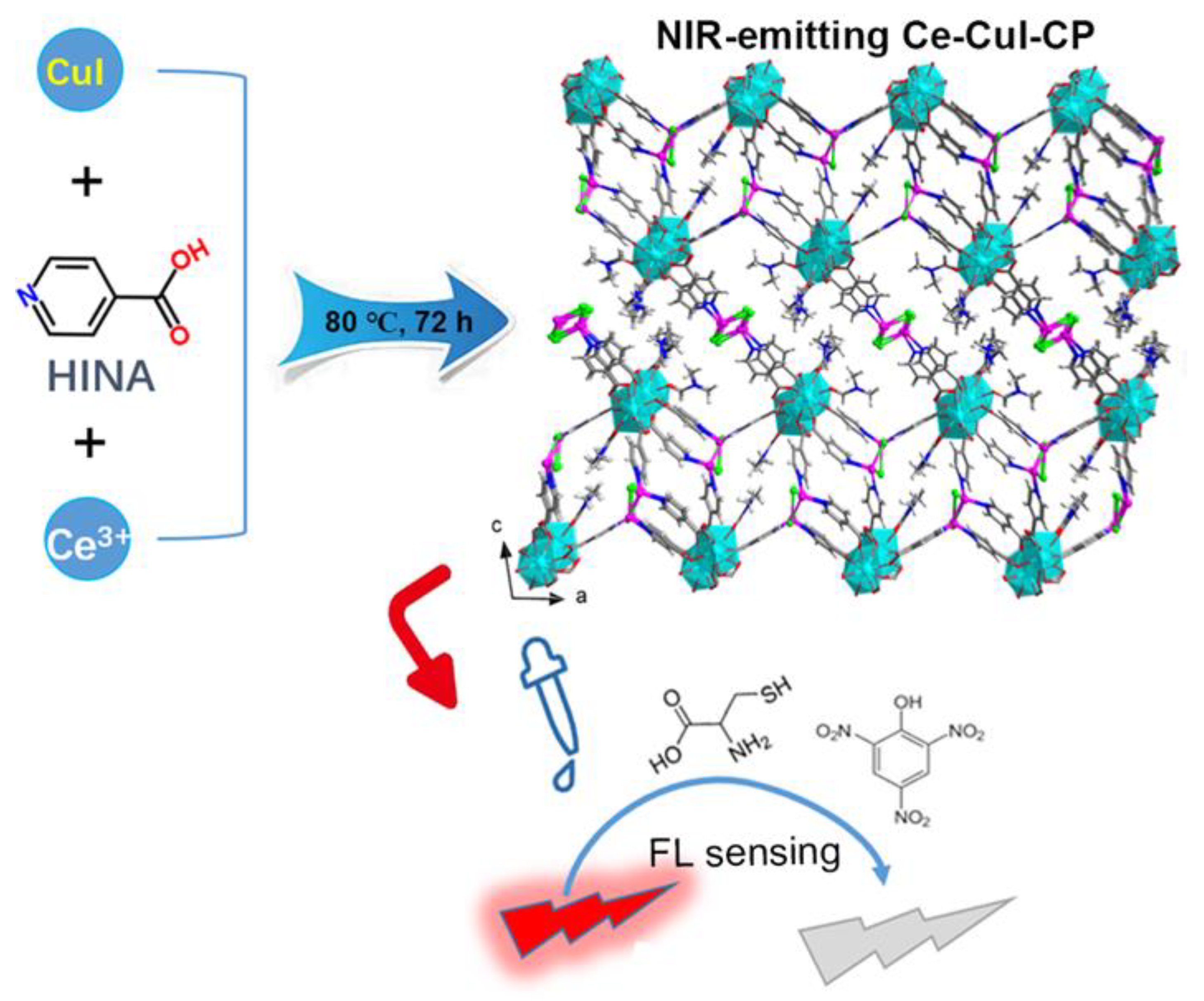


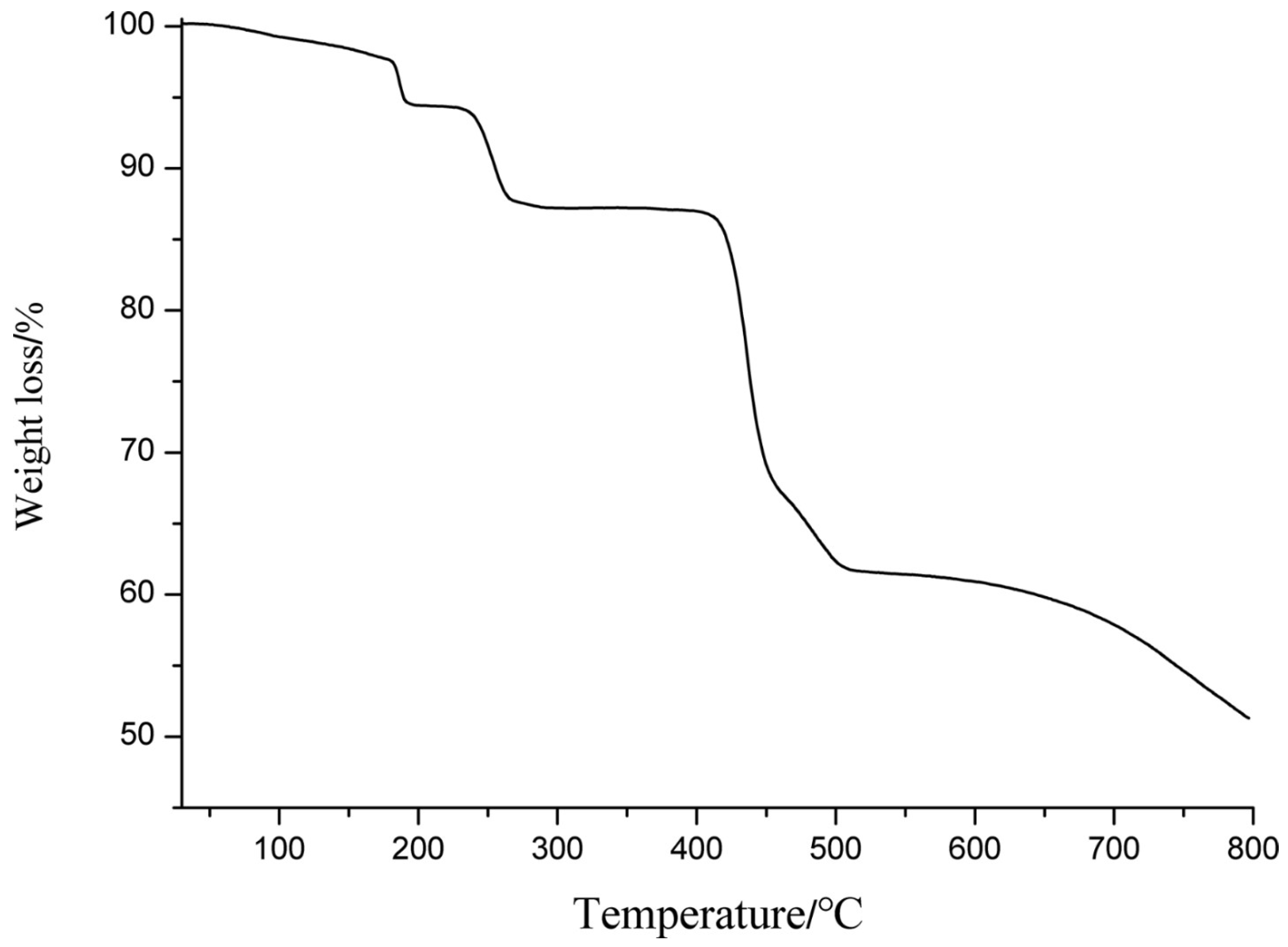

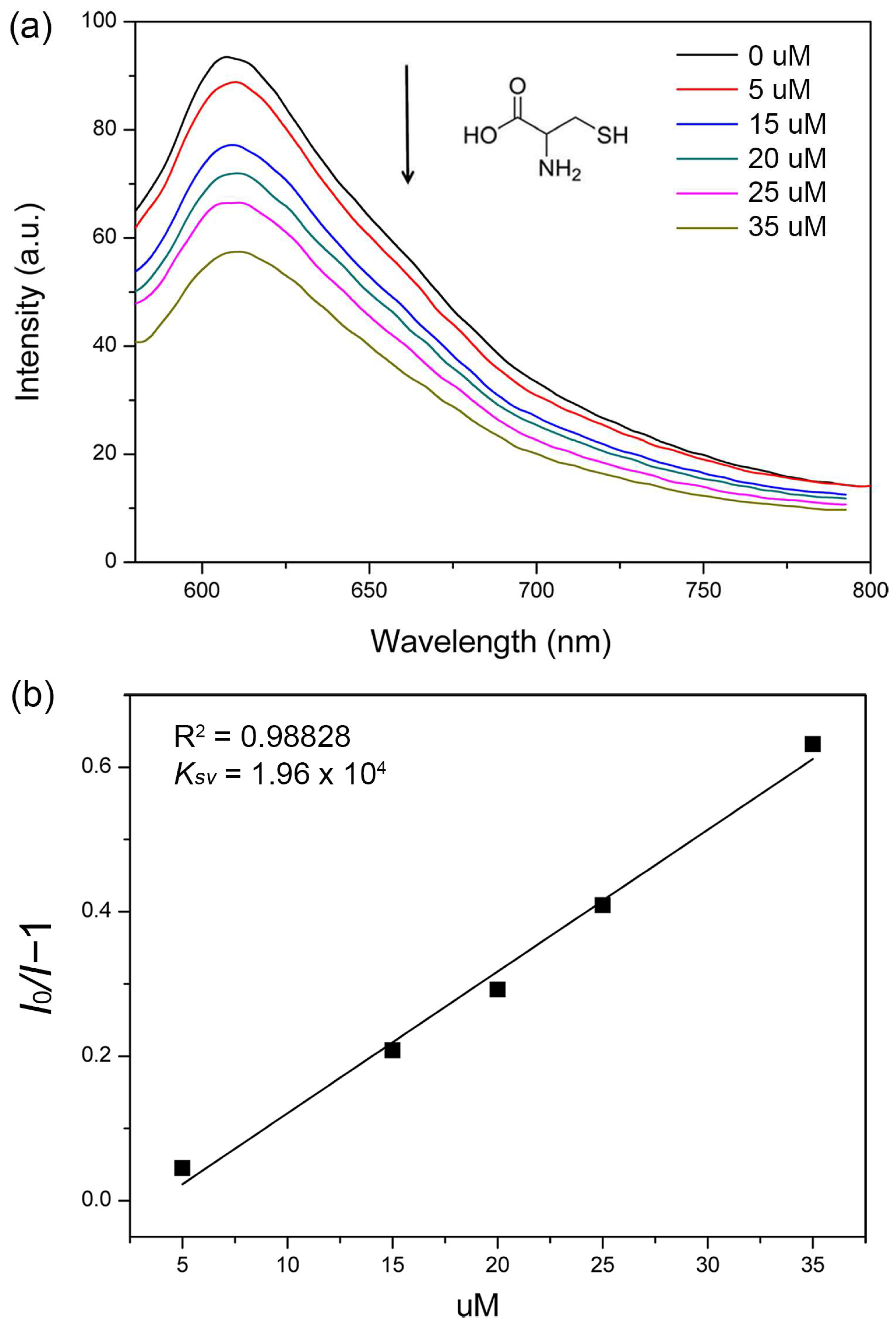
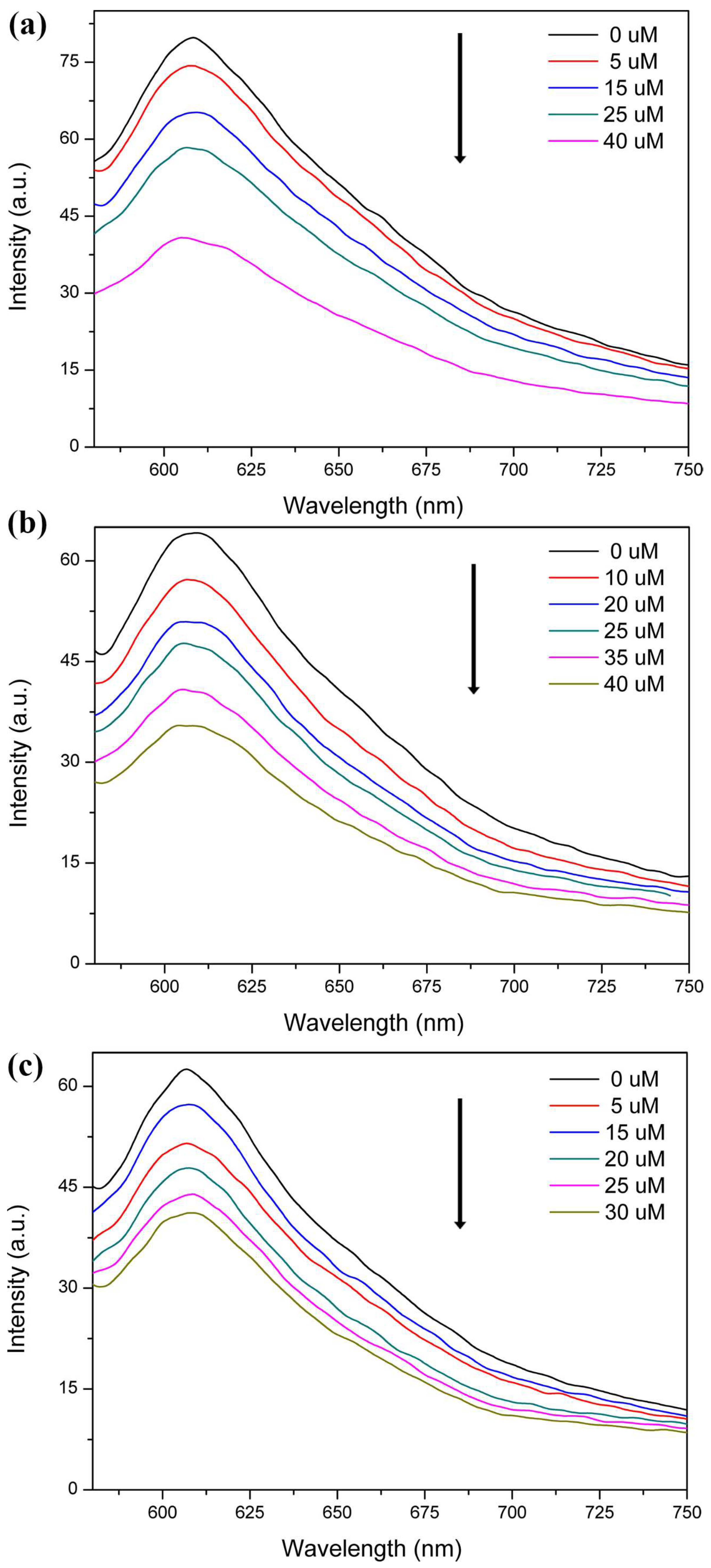
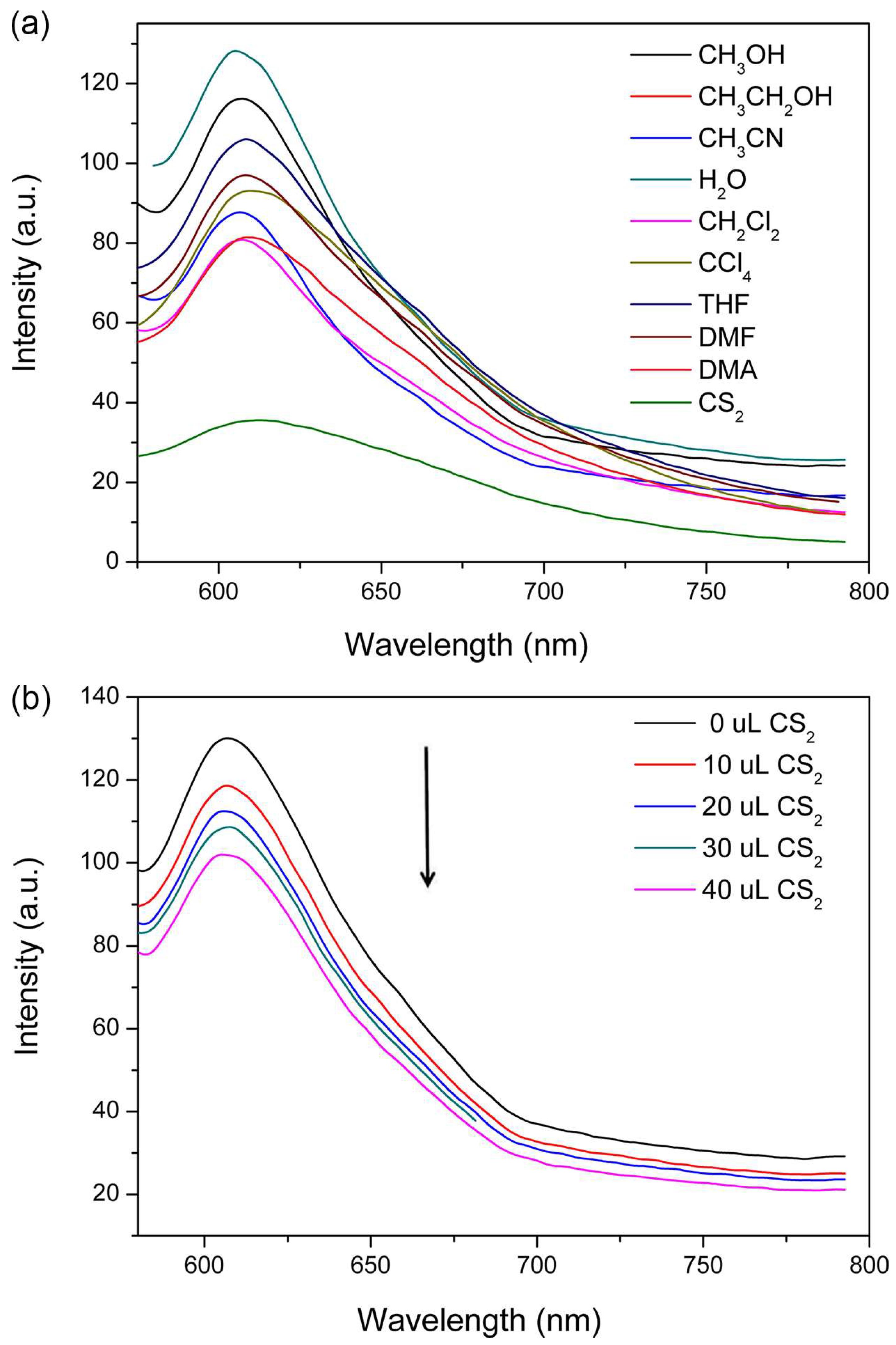

| Empirical formula | C48H52Ce2Cu4I4N10O16 |
| Formula weight | 2066.99 |
| Crystal system | monoclinic |
| Space group | C2/c |
| T/K | 298(2) |
| λ/Å | 1.54178 |
| a/Å | 30.1437(5) |
| b/Å | 8.55370(10) |
| c/Å | 51.9807(9) |
| α/º | 90 |
| β/º | 100.926(2) |
| γ/º | 90 |
| V/Å3 | 13159.8(4) |
| Z | 8 |
| Dc/Mg·m−3 | 2.087 |
| μ/mm−1 | 27.175 |
| F(000) | 7856 |
| Measured refls. | 58,283 |
| Independent refls. | 11,566 |
| Rint | 0.1042 |
| No. of parameters | 712 |
| GOF | 1.058 |
| aR1, bwR2 [I > 2σ(I)] | 0.0735, 0.1854 |
| aR1, bwR2 (all data) | 0.0830, 0.1931 |
| Ce-O bond values | |||
| Ce(1)-O(1) | 2.509(9) | Ce(1)-O(3)#1 | 2.502(8) |
| Ce(1)-O(5)#4 | 2.435(8) | Ce(1)-O(7)#5 | 2.506(8) |
| Ce(1)-O(9)#6 | 2.565(8) | Ce(1)-O(12)#3 | 2.358(9) |
| Ce(1)-O(13) | 2.538(11) | Ce(1)-O(14) | 2.528(10) |
| Ce(2)-O(1) | 2.831(10) | Ce(2)-O(2) | 2.525(8) |
| Ce(2)-O(4)#2 | 2.468(9) | Ce(2)-O(6) | 2.452(8) |
| Ce(2)-O(8)#5 | 2.436(8) | Ce(2)-O(9)#6 | 2.706(8) |
| Ce(2)-O(10)#6 | 2.589(9) | Ce(2)-O(11)#5 | 2.424(9) |
| Ce(2)-O(15) | 2.476(9) | ||
| Cu-I bond values | |||
| Cu(1)-I(1) | 2.626(2) | Cu(1)-I(1)#1 | 2.628(2) |
| Cu(1)-I(2) | 2.737(3) | Cu(2)-I(1) | 2.764(3) |
| Cu(2)-I(2) | 2.635(3) | Cu(2)-I(2)#2 | 2.624(3) |
| Cu(3)-I(3) | 2.674(2) | Cu(3)-I(4) | 2.633(2) |
| Cu(4)-I(3) | 2.592(2) | Cu(4)-I(4) | 2.760(2) |
| Cu-N bond values (Å) | |||
| Cu(1)-N(1) | 2.044(10) | Cu(2)-N(2) | 2.050(11) |
| Cu(3)-N(3) | 2.071(11) | Cu(3)-N(4) | 2.058(10) |
| Cu(4)-N(5) | 2.032(11) | Cu(4)-N(6) | 2.106(12) |
| Compound | Detection Media | Ksv Value/M− | Reference |
|---|---|---|---|
| Compound 1 | ethanol | 1.33 × 104 | This work |
| Cd(INA)(pytpy)(OH)·2H2O | DMF | 4.3 × 104 | [64] |
| [Mg2Zn2(OH)2(NDC)3(H2O)2]·6H2O | ethanol | 0.94 × 104 | [65] |
| UiO-68@NH2 | H2O | 5.8 × 104 | [66] |
| [L4Cd3(H2O)2] | H2O | 6.6 × 104 | [67] |
| [NH2(CH3)2][Zn4O(bpt)2(bdc-NH2)0.5]·5DMF | DMF | 1.69 × 104 | [68] |
| [NH2(CH3)2][Zn4O(bpt)2(bdc-NH2)0.5]·5DMF | 6.19 × 104 | ||
| [Tb2(PBA)3(H2O)3]·DMF·3H2O | H2O | 4.5 × 104 | [69] |
Disclaimer/Publisher’s Note: The statements, opinions and data contained in all publications are solely those of the individual author(s) and contributor(s) and not of MDPI and/or the editor(s). MDPI and/or the editor(s) disclaim responsibility for any injury to people or property resulting from any ideas, methods, instructions or products referred to in the content. |
© 2023 by the authors. Licensee MDPI, Basel, Switzerland. This article is an open access article distributed under the terms and conditions of the Creative Commons Attribution (CC BY) license (https://creativecommons.org/licenses/by/4.0/).
Share and Cite
Tan, B.; Li, Z.-W.; Wu, Z.-F.; Huang, X.-Y. A Cerium Organic Framework with {Cu2I2} Cluster and {Cu2I2}n Chain Modules: Structure and Fluorescence Sensing Properties. Sensors 2023, 23, 2420. https://doi.org/10.3390/s23052420
Tan B, Li Z-W, Wu Z-F, Huang X-Y. A Cerium Organic Framework with {Cu2I2} Cluster and {Cu2I2}n Chain Modules: Structure and Fluorescence Sensing Properties. Sensors. 2023; 23(5):2420. https://doi.org/10.3390/s23052420
Chicago/Turabian StyleTan, Bin, Zi-Wei Li, Zhao-Feng Wu, and Xiao-Ying Huang. 2023. "A Cerium Organic Framework with {Cu2I2} Cluster and {Cu2I2}n Chain Modules: Structure and Fluorescence Sensing Properties" Sensors 23, no. 5: 2420. https://doi.org/10.3390/s23052420
APA StyleTan, B., Li, Z.-W., Wu, Z.-F., & Huang, X.-Y. (2023). A Cerium Organic Framework with {Cu2I2} Cluster and {Cu2I2}n Chain Modules: Structure and Fluorescence Sensing Properties. Sensors, 23(5), 2420. https://doi.org/10.3390/s23052420







